Oysters and Hemlocks: Rekindling Old Friendships
January 1st, New Year’s Day, I donned shorts and boots and headed for Oyster Dome. That’s the prominent rock outcropping rising a couple thousand feet above Chuckanut Drive at the south end of the Chuckanuts or the north end of Blanchard Mountain. It’s a popular hike, despite being steep and muddy. I went for exercise and to rekindle old friendships with the inhabitants of the winter forest.

The view from the top out over the San Juan Islands is spectacular. I made this photo handheld with my little Canon G12 pocket camera, planning to stitch the frames together later in Photoshop. Whenever you’re shooting for a panorama it’s important to keep the horizon level and to overlap adjacent frames up to one third. Turns out I screwed up on the northernmost frame and failed to get any overlap. In fact, I missed a piece of the islands and the last frame wouldn’t stitch. You can’t see that here because it’s not part of the final image. Click on the photo for a larger version.
Like my friend Saxon Holt in his blog post Dusk, Blackwater Pond, I used a software tool, Topaz Adjust, to enhance the color and contrast in the final photo to bring it back to something closer to what I saw in my mind’s eye while standing on the top of the cliff.
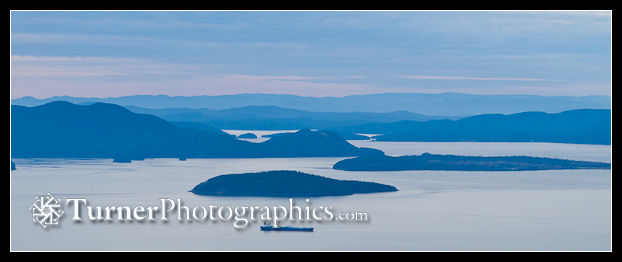
The original, straight from the camera, frames looked rather dull and lifeless. Here’s the northern portion, cropped and with some Lightroom curve and vibrance adjustment but no Topaz processing.
But I’ve digressed a bit. What do I mean by the title, “Rekindling Old Friendships?”
I’ve been hiking in Pacific Northwest woodlands for over twenty years now. I’ve come to recognize most of the plants growing in the forest and think of them almost as friends. So this winter hike on the first day of the year was a chance to say “hello” to all the wintergreen trees and shrubs in our lowland forest. This is a west-facing forest on a steep slope, at the edge of the Olympic rain shadow. The canopy of tall Douglas-firs (Pseudotsuga menziesii) is dense, shading out almost everything else.
Along much of the trail there’s a continuous carpet of sword ferns (Polystichum munitum) which I wrote about over on the Native Plants and Wildlife Gardening blog. In other places I found the thick, leathery leaves of salal (Gaultheria shallon) with its hairy reddish branchlets. There was low Oregon-grape (Berberis nervosa), never more than half a meter tall in this area.
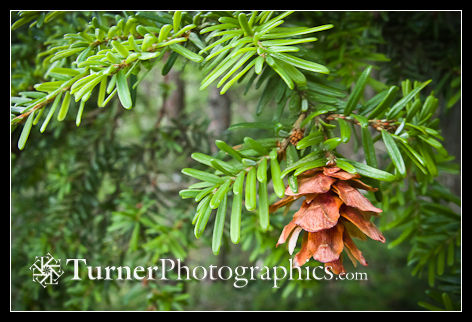
Poking up above the understory shrubs were the shade-tolerant western hemlocks (Tsuga heterophylla). Hemlock samplings are often found on nurse logs, growing slowly in the deep shade, biding their time until a storm blows open a hole in the canopy and letting in sunlight. Then they spring into growth and can ultimately become the climax species. But here on this slope, which has been logged, the Douglas-firs still reign.
Up at the top of Oyster Dome, and among the gigantic boulders at the base, some of the hemlocks were still carrying their diminutive cones. It’s an easy species to recognize, with cones that are roughly a centimeter long and wide, dangling beneath the branches. Western hemlock needles are short, blunt, and held in a mostly flat array on each side of the twigs.
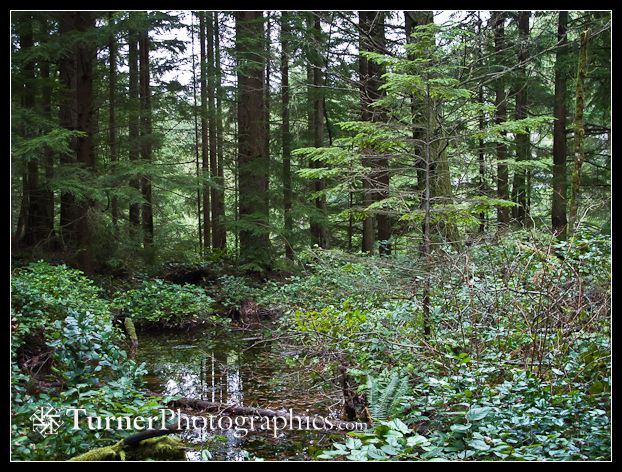
One of the interesting things I came across on this steep hillside is a small flat wetland. It was ringed by salal and Douglas-fir and is near what are locally called the “bat caves.”
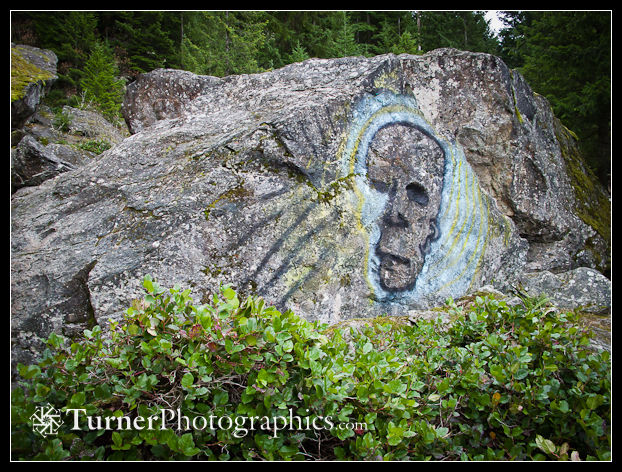
Speaking of the caves, someone has added artistic graffiti to one of the boulders. I’m definitely not a big fan of spray-painting rocks, but I thought this looked rather interesting. The artist obviously saw the face in the rock and applied his (her?) paint around the natural bumps and depressions.
I lingered a while at the top of the cliff and then took my time hiking down. Downhill hiking is always harder on my knees and ankles than going up. When I was a bit more than half way down the sun peeked out under the cloud layer again, lighting up the sword fern carpet. I pulled out my camera for another panoramic, trying to capture a bit of the feeling of being surrounded by dense forest and basking in the weak late afternoon winter sunshine.
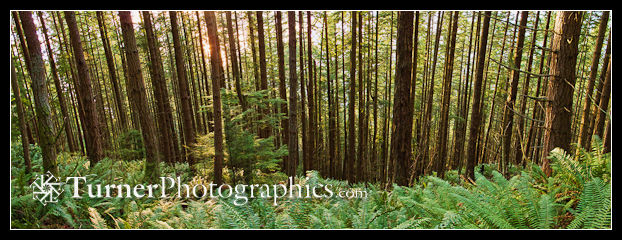
Like the island view I began with, this image was stitched in Photoshop and then processed through Topaz Adjust to lightly enhance the color and contrast.
My title may be a bit misleading. There are no oysters on Oyster Dome unless you carry them up yourself. The name comes from the creek in the valley below, Oyster Creek, which empties onto the mudflats of the Salish Sea, where Taylor Shellfish raises oysters.
I hope you’ve enjoyed meeting some of my floral friends from the winter forest. What are the plants you like to visit and renew friendships with?


Well, Mark, since I don’t get out and about as much as you, my best friends are right in my yard. I prefer to greet them when they return each year. And . . . I don’t have to kill my knees and legs to do so. But your hike sounded fantastic and the scenes you saw are lovely.
Oops I goofed on teh ReCaptcha response – I hate those things when you can hardly read them.
Sharon, nothing wrong with greeting old friends in the back yard, too. I do that as well.